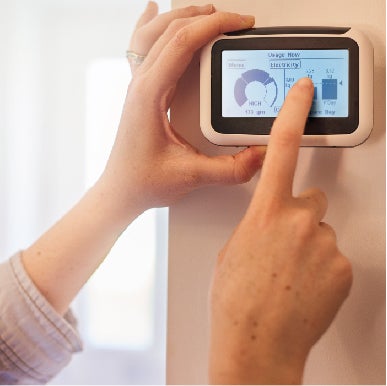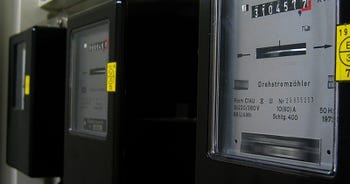A guide to business energy meter installations
If your business is growing, your energy usage will grow with it. Suppose you need to expand your energy capacity, or you’ve moved into premises with no energy meters. In that case, you’ll need to get new meters installed - here’s all you need to know about business gas and electricity meter installations.

Five-point summary
- If you need a new meter installation, you should first identify your energy supply numbers (MPAN for electricity, MPRN for gas) and then work out the right meter type based on your business needs. You can then negotiate the installation cost (smart meters are often free) and book an installation appointment with your supplier.
- Your energy supplier typically installs the meter, and a Meter Operator (MOP) may be required for half-hourly meters. The Distribution Network Operator (DNO) handles new electricity connections. Landlords may be involved if the property is rented.
- There are several types of meters to choose from, based upon your needs. For example, standard, smart, or half-hourly meters for fixed-rate usage. Economy 7, Economy 10, or three-rate meters for varied pricing based on usage times. Prepayment meters require upfront payment and can be useful for cost control.
- Installation costs vary depending on meter type and installation complexity, and fitting can take between 30 minutes and a full day; new connections may take weeks.
- Your MPAN and MPRN are unique numbers that help suppliers identify your premises. If you’ve never been billed, contact your supplier or network distributor to obtain them.
How to arrange a business energy meter installation
These are the steps you'll need to go through to get a new business energy meter installed at your business premises:
- Find out your business electricity and gas supply numbers - These are unique numbers that identify the supply to your property. You can find the Meter Point Administration Number (MPAN) on your latest electricity bill and your Meter Point Reference Number (MPRN) on your latest gas bill.
- Work out which type of meter you need - Not all energy meters are the same, so you should speak with your supplier or the Bionic business energy experts to work out which type you need. To give you a head start, keep reading to find out the types of business electricity and gas meters that are available.
- Negotiate a price for your new meter - While smart meter installations tend to be free, you may be charged a fee for having any other type of meter installed at your business premises, especially if you use large amounts of energy. The good news is, installation costs are usually negotiable, so don’t accept your supplier’s first quote - haggle over the new electric meter installation cost and bargain over a price for commercial gas meter fitting.
- Book your installation appointment - Once you’ve agreed on the type of meter and installation costs, your business energy supplier will assess the work that needs to be done and arrange a day to install the new meter. Once installed, billing will begin on the terms you agreed with your supplier.
If you’re not sure who supplies energy to your property, give us a call on 0800 970 0077. We can help to find your supplier, arrange a meter installation and check if there are any cheaper gas and electricity deals you could switch to.
Who is responsible for installing a business energy meter?
If you need an energy meter fitting at your workplace, organising the installation will either be up to you as the business owner or the landlord if you rent your business premises. The responsibility for fitting the energy meter typically falls on the energy supplier or the local distribution network operator (DNO), depending on the situation.
Here's how it generally works:
- Energy supplier – If you are setting up a new business energy contract or switching suppliers, your energy provider usually arranges for the installation of the meter. This includes both standard and smart meters.
- Meter Operator (MOP) – In some cases, businesses may need to appoint a Meter Operator, especially for half-hourly meters. The MOP is responsible for installing and maintaining the meter.
- Distribution Network Operator (DNO) – If your business requires a new electricity connection, the DNO is responsible for setting up the connection to the grid. Once this is done, a meter can be installed by the supplier or MOP.
- Landlord (if applicable) – If your business is located in a rented property, the landlord may have some responsibility regarding meter installation, especially if the meter is shared among multiple tenants.
If you're getting a gas meter fitted, you'll need to organise the installation with your gas distributor and make sure it's fitted by a qualified Gas Safe engineer.
Where should a gas meter be installed?
Gas meters should be fitted on an external wall that's no more than two metres from the corner of the building on either side of a door or sealed window. There are some instances when a gas meter needs to be fitted inside a building, including:
- If your premises are part of a large industrial estate
- Communal areas in blocks of flats
- In the plant room of an office building
- If your property has a boundary wall directly in front of a footpath
There may be certain other conditions at your building that determine where the meter should be fitted. For the best advice, speak to a qualified and registered engineer.
What are MPAN, MPRN and why do I need them?
Your MPAN (Meter Point Administration Number) and MPRN ( Meter Point Reference Number) are unique numbers that allow suppliers to identify the premises where you're using your energy. Your MPAN number can be found on your latest electricity bill, and your MPRN on your latest gas bill. Learn more about MPAN and MRPN numbers.
If you’ve never been billed, you'll be able to get the number from your current supplier. If you're arranging a new business electricity supply connection, you'll need to contact your local network distributor, who can create one for you.
If you’ve moved into a brand new building, you’ll need to arrange a new connection, here’s how:
- Set up your connection - Your local Distribution Network Operator (DNO) is responsible for setting up your connection, so you’ll need to get in touch with them to arrange a quote for the work. The new electric meter installation cost will depend on where you’re located and the amount of electricity you’ll need.
- Choose an energy supplier - You’ll then need to choose an energy supplier to power your workplace. Give the tech-enabled energy experts at Bionic a call on 0800 970 0077 and we’ll find an energy supplier and tariff to fit the unique needs of your business. prices and choose an energy contract that suits your business.
You’ll then need to agree on the type of meter to be installed, before agreeing a price and installation date, as above. To give you a better idea of the type of meter you might need, here are the different types of gas and electricity meters available to businesses.
How do I know which type of energy meter is right for my business?
Choosing the right energy meter for your business depends on your energy consumption, business size, and operational needs. Here’s a breakdown of the different types of business energy meters and how to determine which one suits you best:
Single rate meters
Single-rate meters monitor your energy usage at a single, flat rate, making them the most popular type of business energy meter, particularly for those that mostly operate during the peak consumption hours between 8 am and 10 pm.
- Standard meter - The most common type of meter, standard meters use one unit rate when measuring your energy consumption, so the cost is the same for every unit, and require you to manually send meter readings to your supplier. If not, you’ll be placed on estimated billing and could find yourself overpaying or underpaying for business energy.
- Business smart meter - Next-generation meters that use wireless tech to automatically send readings to your supplier, smart energy meters provide accurate billing and allow you to stay in control of your energy usage and cut your business energy bills.
- Half-hourly meter - Designed for businesses with high energy demand, these meters take half-hourly meter readings and submit them directly to your supplier. This saves you the trouble of providing manual meter readings and ensures accurate billing. For more information on large-scale electricity meter installation, get in touch with your supplier. You can also find out more about large business energy by checking out our guide to large business and industrial energy prices.
Two-rate meters
Two-rate meters charge two separate rates, depending upon the time of day, with the cheaper unit rates usually charged during off-peak hours, and a more expensive rate for peak hours.
Time of use meters - Also known as Economy 7 and Economy 10 meters, these are two-rate electricity meters that provide separate readings and rates for daytime and nighttime usage. The daily usage rate is higher during peak hours, and the night-time rate is lower for every unit used within an established seven or ten-hour period.
Similarly, evening and weekend meters have two rates, the lower of which is on weekends, making these meters suitable for businesses that use most electricity on weekends.
Three-rate meters
A three-rate meter allows businesses to pay a peak rate, an off-peak rate and a separate rate for weekends.
Evening, weekend and night meters - Another type of time-of-use meter, these meters offer three different rates:
- A more expensive rate for your daytime electricity consumption
- Lower rate for evening and weekend usage
- An even cheaper rate for night-time usage
The rates on time of use meters vary between regions and energy suppliers, so it’s best to check when choosing your business electricity tariff. For more information, call us on 0800 970 0077.
Smart meters (AMR & SMETS)
Smart meters are ideal for businesses seeking automated readings and improved energy management. They automatically send usage data to the supplier. This means bills should be completely accurate and not estimated, which lessens the risk of overpaying or underpaying. They can be a great choice for small-to-medium businesses that want accurate billing and better insights into their energy consumption.
Half-Hourly (HH) meters
Half-hourly meters are best suited for large businesses with high energy demand, typically using more than 100,000 kWh per year. These meters record energy consumption every 30 minutes and automatically send the data to the supplier, ensuring precise billing and better energy management. They are commonly used in factories, manufacturing plants, and large retail stores.
Time-of-use meters (Economy 7 & Economy 10)
Time-of-use meters are ideal for businesses that consume most of their energy during off-peak hours. These meters offer different rates depending on the time of day, allowing businesses to save money by using electricity when demand is lower. They are particularly beneficial for warehouses, bakeries, and other operations that run primarily at night.
Prepayment meters
Although often a more expensive way to pay for energy, prepayment meters can be a good option for businesses that want to control their energy spending upfront. They require prepaid credit to access electricity, helping businesses manage costs and avoid unexpected bills. This type of meter is especially useful for startups or pop-up shops seeking flexible energy payment options.
What’s the difference between single and three-phase supply?
This refers to the voltage of the commercial electric supply you receive. A three-phase supply offers a higher voltage than a single-phase supply.
Businesses that use large specialised machinery (like manufacturers) may be offered a three-phase supply, while smaller businesses, such as retailers and offices, will generally be on a single-phase supply by default.
If you’re still unsure which meter is the best fit for you, we recommend you assess your business operations to determine when you’re using the most gas and electricity.
How much does it cost to install a new meter at a business property?
The amount you pay for a meter installation depends upon the type of meter that's being fitted and the amount of work needed to fit it. Installation costs aren't fixed, so it's worth negotiating the cost with whoever's fitting your meter.
How long does it take to install a new business gas or electricity meter?
The time needed to fit an energy meter depends on the type of meter and whether additional work is needed. Here’s a general guideline:
- Standard or smart meter - Installation usually takes 30 minutes to 2 hours if there are no complications.
- Half-Hourly meter - This can take a few hours to a full day, depending on the complexity of the setup.
- New connection with meter installation - If your business requires a new electricity connection before installing the meter, the entire process can take several weeks, as it involves coordination with the Distribution Network Operator (DNO).
If you operate across multiple sites or have more than one meter at your premises, check out our guide to multi-site meters and multi-site energy management.
To find out which type of business energy meter you need, or to switch to a better deal, get in touch with the tech-enabled experts at Bionic.








